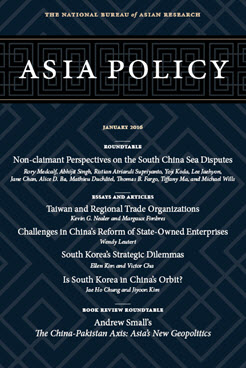Rules, Balance, and Lifelines
An Australian Perspective on the South China Sea
This essay is part of the roundtable ” Non-claimant Perspectives on the South China Sea Disputes.”
A superficial reading of the South China Sea issue, informed by Beijing’s propaganda line that the disputes amount simply to bilateral differences over principally Chinese maritime territory, would suggest that it is none of Australia’s business. In reality, Australia has substantial stakes in what happens in these waters, where assertiveness and the manufacture of militarized islands have raised concerns about coercion and conflict. As a major trading nation, the world’s thirteenth-largest economy, a regional maritime player in the Indo-Pacific, a middle power that benefits from the protection of norms and international law, a partner to its Asian neighbors, and an ally of the United States, Australia has myriad reasons to engage on this important strategic challenge. Historically, it has enacted and gained from freedom of navigation and commerce through this sea and air route. It also has a good record of multilateral diplomacy to reduce regional dangers. Reports of the Royal Australian Air Force quietly exercising freedom of navigation in late 2015 suggest that Canberra will continue to assert its rights and encourage a rules-based international response to tensions. [1] There remains some uncertainty, however, about how far Australia is prepared to go, including in the context of its weighty economic relationship with China.
This essay provides an overview of Australian views on the South China Sea and discusses a range of options available for Australia to protect its interests in this important region.
Looking Back: The Evolution of Australian Views on the South China Sea
Australia is no stranger to the South China Sea. Its air force has exercised rights of overflight and surveillance in these waters since the 1970s, including in support of allied operations to track Soviet ships and submarines during the Cold War. [2] Its decades of trading relations with North Asia have involved heavy reliance on these sea lanes. As an early contributor to regional security diplomacy, including the Association of Southeast Asian Nations (ASEAN) Regional Forum and other ASEAN-centric institutions, Canberra has sustained serious efforts to build the regimes of confidence building, transparency, and conflict prevention that Asia has long needed to maintain stability and guard the gains of prosperity.
Even so, until the upsurge of tensions and assertiveness over the past five years, the South China Sea did not feature prominently in official public documents about Australian foreign and defense policy. A brief survey of the past two decades is illuminating. In the 1980s, despite simmering territorial differences and occasional conflict between China and Vietnam, Australia saw the South China Sea essentially in a Cold War context: the 1987 defense white paper referred to it only as a zone for Australian surveillance flights from a forward base in Butterworth, Malaysia. [3] By the 1994 white paper, with the end of the Cold War, Canberra began to acknowledge concern about “competing territorial claims” among “well-armed nations.” [4] The situation was still seen as one among many regional problems to be “handled carefully” rather than as a major threat. This of course was still an era when China’s growing military power and economic heft were of concern mainly because the country was growing so rapidly, not because of demonstrations of coercive behavior or a perceived ambition to seek to eclipse the U.S.-led alliance system.
Australia’s deepening security anxieties around China’s military power and U.S.-China strategic competition were made plain in the 2009 defense white paper. Yet although worries about China’s maritime ambitions clearly informed this blueprint for a strong Australian navy, the focus was not specifically the South China Sea, which was left unmentioned. This was in marked contrast with a series of policy statements in subsequent years. As territorial tensions rose, and China’s stance from 2009 onward took on characteristics of assertiveness, risk-taking, and sometimes coercion, Australia’s policy position of general concern became sharper and more explicit. In September 2011, Australia and the United States signed on to…
Endnotes
[1] See, for instance, Brendan Nicholson, “RAAF’s China Sea Flight Warning,” Australian, December 16, 2015.
[2] Department of Defence (Australia), The Defence of Australia (Canberra, 1987), 7, 15, 16.
[4] Department of Defence (Australia), Defending Australia (Canberra, 1994), 10.
[5] Department of Defence (Australia), Defending Australia in the Asia Pacific Century: Force 2030 (Canberra, 2009).
Rory Medcalf is a Professor and Head of the National Security College at the Australian National University, Canberra.
About Asia Policy
Asia Policy is a peer-reviewed scholarly journal presenting policy-relevant academic research on the Asia-Pacific that draws clear and concise conclusions useful to today’s policymakers. Asia Policy is published quarterly in January, April, July, and October and accepts submissions on a rolling basis. Learn more


